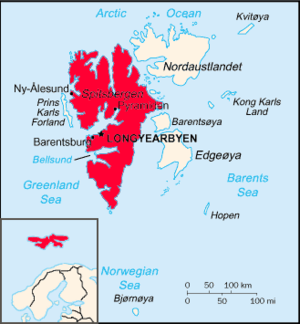Operation Zitronella
Coordinates: 78°54′N 18°01′E / 78.900°N 18.017°E
| Operation Zitronella | |||||||
|---|---|---|---|---|---|---|---|
| Part of World War II | |||||||
 Map of Svalbard with Spitsbergen in the west emphasised | |||||||
| |||||||
| Belligerents | |||||||
|
|
| ||||||
| Commanders and leaders | |||||||
|
|
| ||||||
| Strength | |||||||
|
2 battleships 9 destroyers 600 soldiers[1] |
152 soldiers coastal artillery AA guns[1] | ||||||
| Casualties and losses | |||||||
|
9 killed 49 wounded 3 destroyers damaged[1] |
11 killed 74 captured[1] | ||||||
| ||||||
Operation Zitronella, also known as Operation Sizilien (which translates to Sicily), was an eight-hour German raid on Spitzbergen on 8 September 1943.[2]
Background
During the Second World War, the Svalbard archipelago was the scene of a number of military operations. In August 1941, British, Canadian, and Free Norwegian Forces landed on Spitzbergen during Operation Gauntlet. This was aimed to destroy the rich coal mines there together with associated equipment and stores, which (it was correctly assumed) the Germans intended to make use of. No attempt was made to establish a garrison at this time and the civilian population was evacuated.
In April 1942, a Norwegian force landed at Barentsburg in Operation Fritham to establish a permanent presence in the islands, but this operation met considerable difficulties. Nevertheless, by the summer of 1943, they were well established.
Meanwhile, Nazi Germany had established a number of manned meteorological stations in the Arctic to improve weather forecasts vital for the warfare against Allied convoys from the UK to the USSR. One of the first manned stations, "Knospe", was established in the inner part of Krossfjorden in the main island late 1941 under the command of H.R. Knoespel, following the evacuation of the Norwegian and Russian populations in September 1941.
It was decided to evacuate the "Knospe" weather station during the summer of 1942, as the ice-free season made an Allied attack possible. The submarine appointed for evacuation of the group of six people was U-435, under Kapitänleutnant Siegfried Strelow. The evacuation took place on 23 August 1942 without Allied interference.
Action
In September 1943, it was decided by German Naval Command to attack and destroy the Allied facilities. A naval task force was assembled, comprising the battleships Tirpitz (in her only offensive action), Scharnhorst, and nine destroyers (five Narvik class destroyers: Z27, Z29, Z30, Z31, Z33, and Erich Steinbrinck, Karl Galster, Theodor Riedel, Hans Lody). On 8 September, a battalion of German troops landed, supported by naval gunfire, seizing the facilities at Barentsburg and forcing the Norwegian garrison to withdraw into the hinterland. After destroying the coal depots and other facilities, the German forces voluntarily withdrew from an untenable position.
Aftermath
Under cover of the attack, the Luftwaffe installed a weather station on Hope Island. At the war's end, weather teams on Spitsbergen became the last German troops to surrender: they gave themselves up in September 1945.[3]
Despite victory in the field, Zitronella/Sizilien was only a qualified success for Germany. It brought no lasting benefit; the Allies quickly relieved the men on Spitzbergen and re-established the garrison there. On 19 October, the cruiser USS Tuscaloosa arrived at Barentsburg with relief and reinforcements.[4]
Of the Norwegian prisoners of war taken during the operation, Captain Morten Bredsdorff and 30 others were sent to Oflag XXI-C in Schildberg in the German-annexed Reichsgau Wartheland, joining 1,089 Norwegian officers already interned there.[5]
Evaluation
Samuel Eliot Morison dismisses Operation Zitronella as a political move on the part of the Kriegsmarine, aimed at showing Hitler that the German surface fleet had some value. Morison evaluates the effort as disproportionate to the results, suggesting that the same ends could have been achieved more simply.[6]
See also
- Arctic Ocean operations of World War II
References
- ↑ 1.0 1.1 1.2 1.3 1.4 Torkildsen 1998, p. 221
- ↑ 2.0 2.1 2.2 2.3 2.4 Torkildsen 1998, pp. 221-222
- ↑ Umbreit, Andreas (2009).Spitsbergen, Svalbard, Franz Josef Land, & Jan Meyen. Bradt Travel Guides, p. 37. ISBN 1-84162-240-0
- ↑ Roskill
- ↑ Schiøtz 2007, pp. 202, 330
- ↑ Morison, Samuel Eliot (2002) [1956]. History of United States Naval Operations in World War II. History of United States Naval Operations in World War II Series. 10: The Atlantic Battle Won, May 1943-May 1945. University of Illinois Press. p. 231. ISBN 9780252070617. Retrieved 2012-12-19.
[...] Doenitz decided to justify the existence of this surface navy and give it a little exercise by wiping out the Allied installations at Spitsbergen. [...] One destroyer could easily have done the job.
Bibliography
- Samuel Eliot Morison History of United States Naval operations in World War II : Vol X The Atlantic Battle Won, May 1943- May 1945 (1956) ISBN (none)
- Stephen Roskill : The War at Sea 1939-1945 Vol III (1960) ISBN (none)
- Schiøtz, Eli (2007). Offiser og krigsfange: Norske offiserer i tysk krigsfangenskap – fra oberst Johannes Schiøtz' dagbok (in Norwegian) (1st ed.). Kjeller: Genesis forlag. ISBN 978-82-476-0336-9.
- Torkildsen, Torbjørn (1998). Svalbard : vårt nordligste Norge (in Norwegian) (3rd ed.). Aschehoug, in cooperation with Det norske svalbardselskap. ISBN 82-03-22224-2.